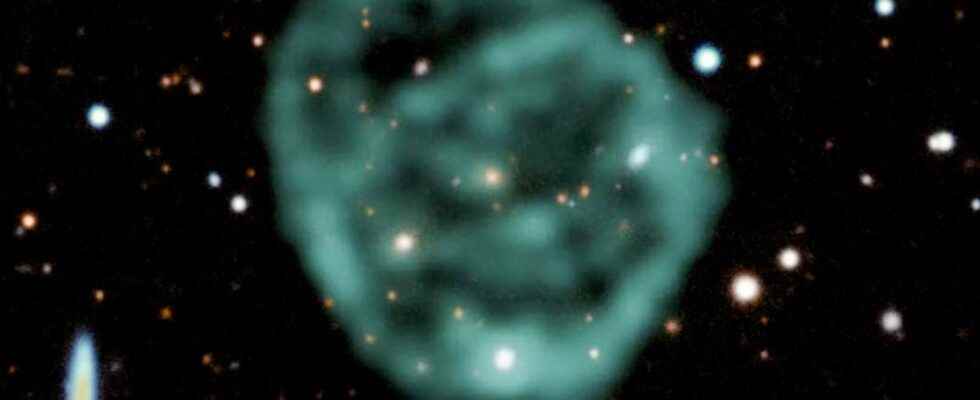In the early 1960s, by successfully identifying the optical counterpart of a source radio powerful discovery by radio telescopes of the time and baptized 3C 273, the astronomers notice that it looks like a star but that its spectrum light is strongly red-shifted. As part of the cosmology relativist of the time already rather well developed, this would mean that it is at billions oflight years distance and that it therefore gives off, to be visible from so far away, quantities ofenergies prodigious and almost unbelievable, because no normal star or even star explosion can physically account for it.
Several hypotheses exotic are proposed to explain the existence of this source, and other similar ones, which radio astronomers will discover during the same decade. A conservative hypothesis supposed that they were indeed stars but very massive and therefore possessing a significant redshift due to their field of gravitationa well-known prediction of general relativity theory since its discovery by Einstein. These stars would then be close and their brightness intrinsic would then have nothing extraordinary.
Other researchers, during the same decade when the big bang theory will quickly impose itself after the discovery of the cosmic radiation in 1965, are more daring and explore, like Igor Novikov and Yuval Ne’eman proposed it, the idea that what we already call quasars could be parts of theUniverse whose expansion at the time of big Bang had been delayed (assumption of lagging core). They will even go so far as to suggest that these cosmic phenomena are the other end of wormholes ejecting the matter which they had absorbed in the form of black holes in another part of the cosmos, or even in another universe.
We think we know now that quasars are active nuclei of galaxies containing a supermassive black hole accreting matter, such as M87*, now imaged by members of the collaboration Event Horizon Telescope.
From quasars to ORCs
However, since 2019, British-Australian astronomer Ray Norris and his colleagues have been very perplexed by a handful of objects they have discovered using theAustralian Square Kilometer Array Pathfinder (Askap), the Australian radio telescope network that served as the prototype for the highly anticipated Square Kilometer Array (SKA), a virtual giant radio telescope project, with a collecting surface equivalent to one square kilometer, in progress and which combines several instruments.
The first unusual object revealed by Askap was named ORC 1, ORC for acronym of ” odd radio circles “, which can be translated as ” strange radio circles “.
As their name suggests, they appeared on radio in the form of rings but with nothing associated with them in the visible domain, which eliminated the hypothesis that they could be remains of supernovae or some planetary nebulae who can also look like this. It could also be dismissed as unlikely that they are radio lobes associated with supermassive black hole jets because they are much more irregular.
The distance and therefore also the size of these circles were not yet determined at the beginning. But that has just changed and a publication in Monthly Notices of the Royal Astronomical Society (MNRAS), which can be consulted freely at arXiv, begins to give some answers.
Astronomers have mobilized the South African MeerKAT radio telescopealso a precursor of the SKA to which we already owe discoveriesto observe with a better resolution ORC 1. It was then possible to find a new radio source in the center of the radio circle, a source that could be associated with a galaxy. In the end, the data collected now suggests that we are in the presence of a ring located a billion light-years from the Milky Way and correspondingly about a million light-years in diameter.
Similar conclusions were reached with MeerKAT and it now seems that ORCs are gigantic bubbles of very hot gas whose outlines appear brighter, because we see in slice a greater thickness of matter containing relativistic electrons forming a plasma immersed in from magnetic fields and which radiates accordingly. The presence of magnetic fields is revealed by the polarization of radio waves measured with MeerKAT. This type of radiation called synchrotron, because observed in these particle accelerators on Earth, is well known in the Milky Way and also in the crab nebula.
The bubbles appear centered on the detected galaxies and therefore it seems clear and established that they were blown by these galaxies as if it were the front of the shock wave of a quasi-spherical explosion.
Artist’s impression of the formation of one of the strange radio circles from an explosion from a central galaxy. It is believed that it took 1 billion years for the bubble from the explosion to grow to the size we know today. The radio circles are so large (millions of light-years in diameter) that they have extended beyond their source galaxies. © Sam Moorfield/CSIRO
The nature of the explosion remains elusive however. It could be an unpredicted and unobserved phenomenon when two supermassive black holes collide after the merger of two galaxies.
It could also be a sudden formation by collapse gravitational force of about one million stars in a galaxy, with the birth of these stars causing a sudden blast of plasma leaving the galaxy.
We should know more with an additional gain in resolution once the SKA is fully operational.
Support your independent scientific media: discover our subscription formulas!
4 good reasons to subscribe to Futura on Patreon:
- A site without any advertising from 3.29 euros per month.
- It is without commitment.
- Access to priority content, in preview, just for you.
- You support our business in the best possible way. A real motivation for us!
Interested in what you just read?
